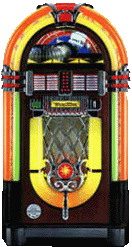 |
ARCHIVES | |
| R&B/SOUL SINGLES | ||
|
|
The ’40s:

The ’50s:

The ’60s:

The ’70s:

The ’80s:

The ’90s:

Also in This Archive:
• POP SINGLES
• COUNTRY SINGLES
• POP ALBUMS
In the issue dated October 13, 1947, Cash Box added another Top 10 regional “Hot” chart, under the banner “Hot On Chicago’s South Side.” Over the next several years, “Hot” charts from other locations were added, until by May, 1952, there were a total of six main regional charts (Harlem, Chicago, New Orleans, Dallas, Los Angeles and St. Louis), as well as a number of others. This archive focuses soley on the six main charts, since they were more-prominently displayed and were the only ones published every week. (Note: Dallas replaced Detroit, which earlier had been one of the main regional charts.)
In the issue dated March 7, 1953, Cash Box introduced its national R&B chart, under the banner “The Nation’s Rhythm & Blues Top Ten.” For the first few weeks, the national chart was displayed at approximately the same size as the individual regional charts; after that, it was given greater prominence. At that point, the focus of this archive shifts to the national chart, since it was the forerunner of the R&B charts in subsequent years; and, beginning with the first week of April 1953, only that chart appears in the archive.
The depth of the national R&B chart increased from 10 to 15 positions in the Feb. 27, 1954, issue; to 20 positions in the Oct. 27, 1956, issue; to 25 positions in the May 25, 1957, issue; to 30 positions in the Feb. 15, 1958, issue; and to 50 positions in the Sept. 20, 1958, issue.
In the issue dated July 25, 1970, the depth of the R&B chart was increased to 60 positions. It was expanded to 65 positions in the issue dated February 17, 1973; to 70 positions in the issue dated May 5, 1973; and to 100 positions in the issue dated June 7, 1975.
In the issue dated September 9, 1978, the R&B section of the magazine was rechristened Black Contemporary, although the banner over the singles chart was shortened to just Cash Box Top 100. In the issue dated April 10, 1982, the banner itself was changed to read “Top 100 Black Contemporary Singles.”
In the issue dated January 21, 1989, Cash Box went back to using the term R&B, until the issue dated May 27, 1995, when the banner was changed to read “Top 100 Urban Singles.”
(Click on the links to the left to access the Pop Singles, Country Singles and Pop Albums sections of the archive.)

Play the Jukebox